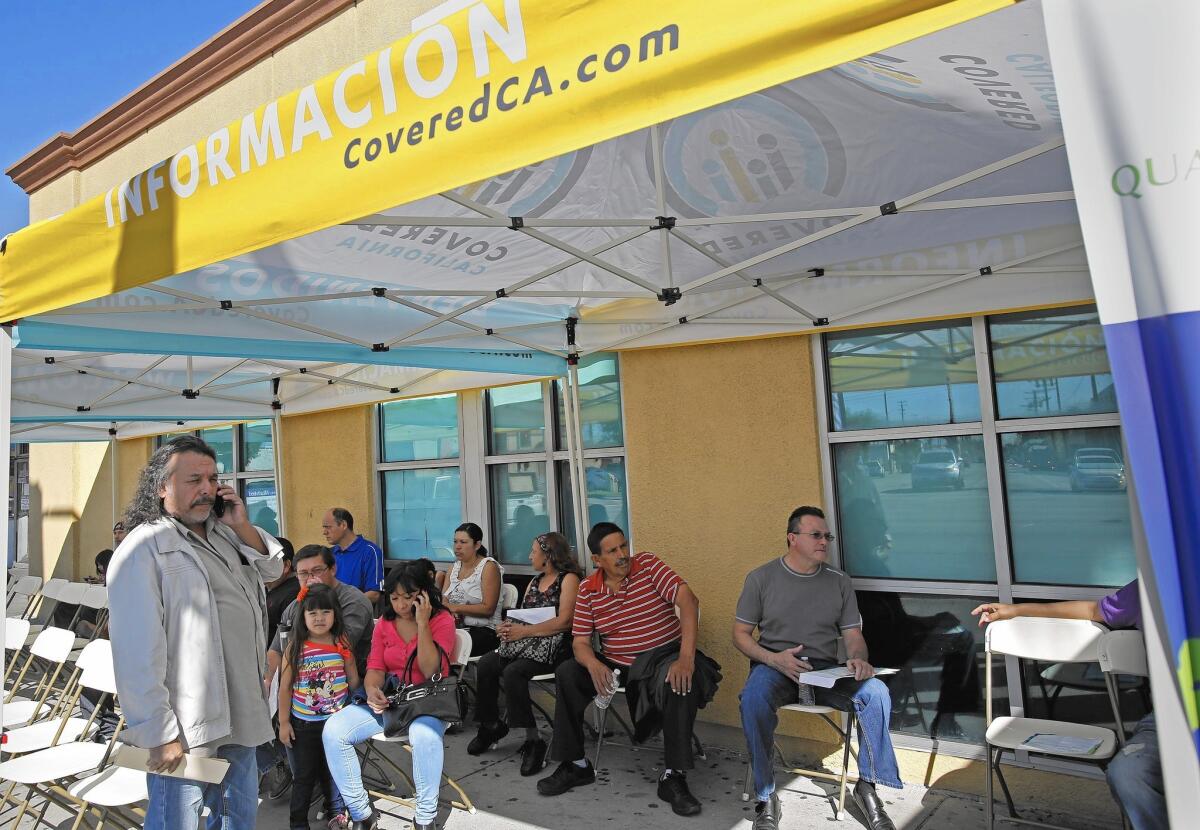More than 85% of Obamacare enrollees qualify for subsidies

- Share via
REPORTING FROM WASHINGTON — More than 85% of Americans who signed up for health coverage this year through the Affordable Care Act qualified for government subsidies, according to a new report that underscores the scope of the aid at a time when the Supreme Court is considering sharply restricting it.
Altogether, close to 10 million of the 11.7 million people who enrolled in coverage this year could get subsidies, the report from the U.S. Department of Health and Human Services shows. Of that, nearly 1.3 million Californians qualified for assistance.
Reliance on government aid is higher in states where the federal government operates insurance marketplaces than in states like California that run their own systems.
The legal challenge being considered by the Supreme Court would strip away subsidies in states that rely on the federal government, affecting as many as 7.7 million people, according to the report.
In many of those states, consumers are getting subsidies that top $300 a month on average, according to the data.
In Mississippi, for example, that has meant the difference between an average monthly premium of $405 without subsidies and $52 with them. In Texas, the average premium drops from $328 a month to $89 a month with aid.
“We now know in very tangible terms how much assistance the Affordable Care Act is providing to people,” said Larry Levitt, senior vice president at the nonprofit Kaiser Family Foundation, which has been closely tracking implementation of the law.
“These subsidies have put health insurance within reach for people who couldn’t possibly pay hundreds of dollars per month on their own.”
The 2010 health law allows Americans who don’t get health benefits at work to shop among plans on state-based marketplaces. The marketplaces are operated by the federal government in 37 states and by the states themselves in the rest, including California, Connecticut and Maryland.
Consumers making less than four times the federal poverty level — or about $47,000 for a single person or $97,000 for a family of four — qualify for subsidies. Insurers must provide a basic set of benefits and cannot turn away consumers, even if they are sick.
The Supreme Court case, King vs. Burwell, was brought by a group of conservative and libertarian activists who argue that a strict reading of the statute makes the subsidies available only in the states that established their own insurance marketplaces.
In some of the states that use the federal HealthCare.gov system — including Alaska, Georgia, Mississippi, North Carolina, Wisconsin and Wyoming — at least 90% of enrollees qualified for the aid this year.
In Florida, which topped all states in 2015 with nearly 1.6 million enrollees, 93% are eligible for subsidies.
Illinois, another state that saw a large surge in enrollment this year compared with 2014, had relatively fewer residents getting assistance, with 78%.
Consumers in states that operate their own marketplaces generally are less reliant on the subsidies, with fewer than two-thirds of enrollees qualifying in Colorado, Massachusetts and Vermont.
In California, on the other hand, 9 in 10 enrollees could get assistance, the report shows.
All of these numbers may change as consumers drop coverage or switch plans in coming months. If last year is a guide, the number of people enrolled will decline over the course of the year as some people fail to pay their premiums and others obtain coverage through a job or some other means.
There may be a surge of sign-ups next month, however, as the Obama administration opens a special enrollment period for people who do not have coverage and were subject to a penalty on their 2014 taxes.
It remains unclear what will happen if the Supreme Court strikes the subsidies in the states that rely on HealthCare.gov. Most experts believe that Americans who lose their subsidies would drop coverage, setting off a sweeping disruption of dozens of state insurance markets.
Twitter: @noamlevey
More to Read
Inside the business of entertainment
The Wide Shot brings you news, analysis and insights on everything from streaming wars to production — and what it all means for the future.
You may occasionally receive promotional content from the Los Angeles Times.











